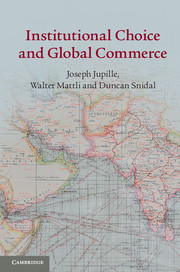3 - Building Theseus’ ship
Why the ITO failed, the GATT succeeded, and the WTO emerged
Published online by Cambridge University Press: 05 June 2014
Summary
Introduction
Upon his return to Athens after slaying the Minotaur, Theseus’ ship was preserved as a memorial. As various planks and parts of the ship decayed, they were replaced with new ones until no original parts were left. This led to Theseus’ paradox: is a ship that has had all of its parts replaced still the “same” ship?
The GATT/WTO is the Theseus’ ship of international institutions. After its tentative origins in the General Agreement on Tariffs and Trade (GATT) and through a series of GATT negotiating “rounds” over the next forty years, the planks of the postwar trade regime have been largely replaced and ultimately rebuilt as the World Trade Organization (WTO). Some parts are fundamentally new, but many planks remain the same. Unlike Theseus’ ship, the design has changed but there is nevertheless surprising continuity. In what sense can we call this institutional Change – or perhaps even Creation of a “new” institution?
Other institutional puzzles are wrapped inside the postwar development of the trade system. Before the GATT, the International Trade Organization (ITO) had been designed to be the formal trade governance counterpart to the International Monetary Fund (IMF) and the World Bank. States rejected the ITO in 1948 yet, in 1995, they embraced the WTO which bore important similarities to it. Why did states reject a strongly institutionalized trade regime at mid century and then Create one nearly as institutionalized at century’s end? In the interim, the GATT operated as a minimal institution that states deliberately kept as weak as possible – yet it nevertheless evolved into a remarkably resilient arrangement even before states recognized the necessity of Creating the stronger WTO.
- Type
- Chapter
- Information
- Institutional Choice and Global Commerce , pp. 53 - 102Publisher: Cambridge University PressPrint publication year: 2013



